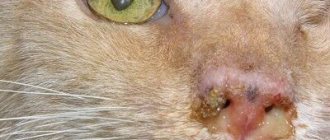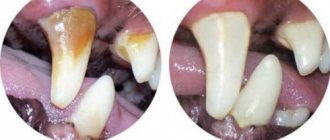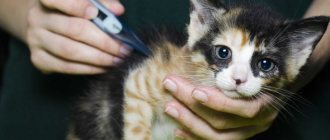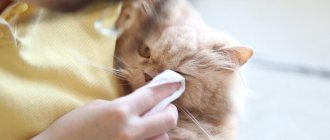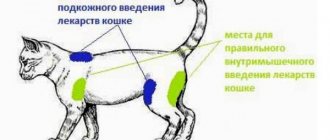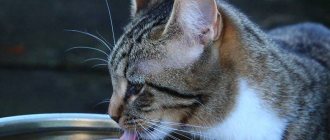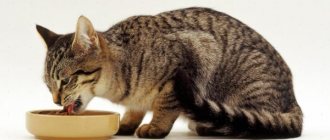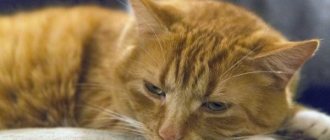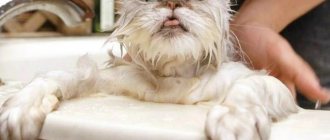There are several reasons why your pet needs a gastric lavage. The most common of them is poisoning from poor-quality food, or the inability of the stomach to digest it. Another reason for intoxication is that when cats wash their fur, they lick it and thereby “swallow it.”
Also, quite often in cats the gag reflex is triggered on its own, but this does not always happen and in such cases the animal needs to come to the rescue and rinse the stomach with a special solution that you need to prepare yourself.
The main indications for cleansing the stomach of a cat
Gastric lavage for cats is most often performed in emergency situations. Cats are less susceptible to poisoning than dogs. They are more picky about food, rarely eat rotten and spoiled food, but still acute intoxications and poisonings occur quite often among them, you need to be prepared for their development. Below are the main indications for emergency gastric lavage at home:
- Food poisoning can occur as a result of animals consuming expired food or meat. Dry food practically does not change its smell and taste after the expiration date, the animal can eat it. Check the manufacturing date of all food you give your pet.
- Poisoning from household detergents. Some cats are attracted to the smells of bleach solutions and various chemicals.
- Drug intoxication can develop if medications are left within the reach of the animal. Cats may like the smells of fragrances that are added to medications, for example, menthol, lemon balm, valerian.
- The development of adverse reactions, allergies, after the use of anti-worm medications by an animal. These medications may be toxic to your pet. The rules for their administration and dosage should be discussed with your veterinarian.
- Cat eating rodents poisoned with rat poison.
Please note that if the animal does not live in an apartment, but in the private sector, it can be poisoned by various poisons. Such intoxications are the most severe and often lead to the death of the pet.
Main symptoms of food poisoning in cats
Symptoms of food poisoning in cats develop during the first 4-6 hours after eating low-quality, spoiled food. The rate at which they increase depends on the type of toxin and the amount eaten. In kittens, symptoms appear more quickly.
Signs of food poisoning in cats:
- repeated vomiting of food, bile, mucus or stomach acid. Animals that are vomiting constantly smack and lick their lips;
- repeated and profuse diarrhea. The stool may be foamy, streaked with blood and mucus, and have a foul odor;
- reduced activity of the pet. The cat constantly lies down, does not walk around the house, does not play;
- anorexia – complete lack of appetite;
- hyperthermia. With food intoxication, the temperature can rise to 40 degrees;
- breathing disorder. It becomes frequent, more superficial, similar to shortness of breath;
- tachycardia is a rapid heartbeat, it develops as a result of dehydration and severe intoxication syndrome. When body temperature rises by 1 degree, the pulse accelerates by 10-15 beats/min;
- In case of severe intoxication, cramps in the skeletal muscles and impaired consciousness of the pet are possible.
Due to repeated vomiting and diarrhea, severe dehydration develops, in which visible mucous membranes become dry and the eyeballs become sunken.
In what cases is it forbidden to rinse the stomach on your own?
There are situations in which it is strictly prohibited to rinse an animal’s stomach. First aid in such cases should be provided by a veterinarian as soon as possible after the first symptoms of the pathology appear. Contraindications to self-gastric lavage include:
- Gastrointestinal bleeding, which can develop as a result of cat poisoning with rat poison or the use of detergents and various chemicals. This condition is characterized by vomiting and black diarrhea. If there is internal bleeding, the animal should not have its stomach washed or given any medications or drinks. All this can increase blood loss.
- Poisoning with acids or alkalis. With this pathology, stomach cleansing is carried out through a tube in a veterinary clinic.
- Impaired consciousness of the pet. In this case, self-washing can lead to choking on vomit.
Method for cleansing the stomach at home
It is not difficult to rinse a cat’s stomach correctly.
When performing this procedure, there is no need to feel sorry for her and stop the manipulation when you see that she doesn’t like it. You must understand that you are cleaning the gastric cavity for the benefit of the animal, and at the moment its life depends on you. To lavage the stomach at home, you need a 20 ml syringe, plain water at room temperature and salt. Pour 40-60 ml of water into the cat's mouth with a syringe (without a needle), then apply a little salt to the root of her tongue with your finger. Salt will cause vomiting and the stomach will be cleared of toxins. This procedure can be repeated several times.
Remember that gastric lavage for animals is prohibited using a solution of potassium permanganate. This substance can cause burns to the mucous membranes of the esophagus and cause severe intoxication.
Gastric lavage for a cat at home: instructions
Curious pets are often subject to severe poisoning by various substances, and sometimes flushing the cat’s stomach is the only way to save the pet’s life.
Unfortunately, only a few animal owners know how to carry out the procedure correctly.
Despite the fact that gastric lavage requires compliance with strict rules, every cat owner should be prepared for it, because not a single animal is insured against an accident.
Why do cats need gastric lavage?
Your furry pet can get poisoned by anything, because cats love to poke their noses where they shouldn’t. An animal can eat a poisoned rat, mouse, taste medications, poisonous plants, and detergents.
Sometimes cats can swallow small indigestible objects (threads, ropes) or eat spoiled food. Almost all cats (feeding hairless Sphynx cats) perform a daily hygiene procedure - they carefully shed their own fur. Once in the stomach, day after day the wool gets compacted more and more densely.
If the animal does not clear the muscular organ by vomiting, it will cause a blockage.
Poisoning with spoiled foods, poisons, dangerous plants, and chemicals causes severe intoxication of the animal’s body. Urgent measures must be taken, otherwise the toxins will quickly be absorbed into the blood and the cat will die.
In this case, flushing the cat’s stomach is the only chance to save your furry pet.
The procedure can be done not only in a veterinary clinic, but also at home, especially since some poisonings cause death in minutes, and it is impossible to get to the nearest hospital.
Symptoms of poisoning
Depending on what the cat was poisoned with, signs of intoxication may differ significantly from each other. When a cat eats rotten or sour products, the animal experiences vomiting with mucus or blood, diarrhea with a foul odor, and refusal to eat. The animal looks a little lethargic, lies down more, loses interest in games, and its body temperature is elevated.
As a rule, such poisoning is not considered dangerous and in most cases goes away on its own after some time. But if after several days the cat still does not show the desire to eat and move, the diarrhea and vomiting do not go away, the animal may die from dehydration.
In this case, it is necessary to lavage the cat’s stomach, and then show the furry pet to a veterinarian.
Intoxication with poisons and chemicals is accompanied by more pronounced symptoms:
- the animal often vomits, and the vomit may contain an admixture of blood and bile;
- the cat completely refuses food, in some cases even water;
- the pet’s condition is depressed, lethargic, the pupils are dilated;
- the cat's breathing is heavy, frequent, heartbeats are not clearly audible;
- swelling of the joints and an increase in abdominal volume may be observed;
- decreased body temperature;
- blood leaks from the nose, mouth, anus;
- saliva production increases;
- There is diarrhea (sometimes black).
The presence of blood in vomit, feces, or discharge from the eyes, nose, or rectum indicates internal bleeding.
This complication occurs when anticoagulants (toxic substances used to bait mice and interfere with the process of blood clotting) enter the cat’s body.
In this case, gastric lavage for the cat is unacceptable; the best solution would be an urgent visit to the veterinarian. Recommendations on what to do if your cat ate a poisoned mouse.
If a cat’s stomach is firmly clogged with hair, and the animal is unable to get rid of the problem on its own (by vomiting), the owner notes the following signs:
- refusal of food;
- pallor of the mucous membranes;
- depressed state, desire to hide in a hard-to-reach place;
- constipation.
Most cats get rid of swallowed hair by vomiting, but sometimes the animal is not able to remove tightly compressed clumps. To help your pet and avoid unpleasant consequences, you need to know how to rinse a cat’s stomach.
How to rinse a cat's stomach at home
Most poisonings require an immediate visit to the veterinarian, but how to flush a cat’s stomach when it is impossible to get to a hospital? To cleanse the muscular organ of toxic substances, you will need the following items:
- 2 glasses of warm boiled water;
- a tube made of rubber, flexible plastic (cut off from the drip system);
- syringe without needle, teaspoon.
You need to pour water into your stomach carefully. The cat is carefully secured, its mouth is opened, and a piece of rubber tube is inserted under the tongue. Using a spitz, they begin to slowly introduce boiled water into the other end of the tube. But how to rinse a cat’s stomach at home when there is no syringe or tube? Add liquid easily using a teaspoon.
To do this, the animal's muzzle is firmly fixed and liquid is poured into the toothless space, which is located on the sides of the jaw. For a better swallowing effect, it is recommended to gently stroke the cat's throat.
Before you rinse your cat’s stomach at home, you need to make sure that the pet is conscious and can swallow the liquid on its own.
It is allowed to use no more than 500 ml of liquid in one procedure; a larger volume of water will cause the liquid to leak into the intestines along with toxins.
How to rinse a cat's stomach to induce vomiting faster? To speed up the onset of vomiting, add a little table salt or sodium bicarbonate (soda) to the water. You cannot use a solution of potassium permanganate, even a very weak one.
If potassium permanganate crystals get on the mucous membrane of the esophagus or stomach, a burn will occur. How to rinse a dog's stomach, read here.
Other help for poisoning cats
Cleaning the stomach is an effective procedure that allows you to quickly remove toxins from the animal’s body, but in some cases (severe intoxication) it is not enough. After completing all manipulations, it is recommended:
- Give the cat an enema using a rubber bulb with boiled water (50 ml).
- Give your cat water more often (every 10-15 minutes).
- After gastric lavage, the cat is given an adsorbent agent inside. If activated carbon is used, it can be given whole or crushed into powder and mixed with liquid (1 mg of the drug per 1 kg of animal weight). Among the effective sorbents are also Polysorb and Enterosgel.
- Be sure to show the cat to a specialist. Only a doctor can objectively assess the victim’s condition and prescribe the necessary treatment and diet.
The owner of a furry pet must know how to perform gastric lavage on a cat. Not a single animal is insured against severe poisoning and it is not always possible to quickly get to a veterinary hospital. Gastric lavage is sometimes the only measure of help that saves four-legged friends.
Source: https://otravilsya.com/zhivotnye/promyvanie_zheludka_koshke/
What else can you do to help your pet in case of acute poisoning?
When the first symptoms of poisoning develop, the cat’s stomach should be rinsed. But this procedure alone is not enough when providing first aid.
After cleansing the stomach, you should:
- Do a cleansing enema. To carry it out you will need baby pears with a volume of 50 ml. The enema should be done with plain water at room temperature. It should be carried out 2-3 times until clean intestinal rinsing water appears.
- Give the animal sorbents. You can use simple activated carbon. Grind half a tablet of coal and dilute it in 5 ml of water. Inject the resulting solution into the cat's mouth through a syringe without a needle.
- Give your pet plain water. Every 15 minutes, inject him with 5 ml of liquid through a syringe.
After providing first aid, you should immediately take the cat to a veterinary hospital. There the doctor will conduct an examination and examination and prescribe treatment. For some time, you will need to bring the cat to the clinic for IVs and examination, feed it according to the diet prescribed by the doctor, and give it medications.
To clarify the diagnosis and identify complications, it may be necessary to conduct a general and biochemical blood test, bacteriological culture of stool, and ultrasound examination of internal organs.
Gastric lavage is an important treatment procedure for cat poisoning. All people who have pets at home should know the rules for conducting it. Stomach cleansing is carried out using a 20 ml syringe and plain water. It is prohibited to use potassium permanganate to treat animals. In addition to cleansing the stomach, if acute poisoning develops, you should do a cleansing enema and give your pet sorbents and drink. After first aid is provided, the cat should be taken to a veterinarian for examination. Self-medication is very dangerous.
This article was prompted by a recent incident. My Chupacabra really loves grass, a special green grass that is sold in pet stores. And then one day I bought him the wrong grass.
Although, it would seem, how can a pet store sell some kind of different herb!
In the evening, Chupacabra was gnawing grass with pleasure, and at night strange sounds were heard. And in the morning I discovered several strange puddles on the floor - Chupacabra was vomiting at night.
But since we are all accustomed to the fact that cats spit up their fur from time to time, especially if they are fluffy, I did not pay attention to this. And she went to work. And in the evening I found several more caustic puddles on the floor and a completely exhausted Chupacabra lying on the bed like a rag. The cat was clearly poisoned. But what could he have poisoned himself with?
Naturally, the newly acquired weed went into the trash, and the Chupacabra still had to be treated for several days. No one could have expected such a situation from simple cat grass.
Symptoms of poisoning in cats
If a person himself can, in most cases, determine his poisoning by two or three symptoms, then as for a cat, not everything is so simple. Much depends on what poisoned the animal. If these are spoiled products, the symptoms will be the same, but if they are rat poison or household chemicals, then there is a completely different clinical picture.
Symptoms of poisoning in cats and cats are:
- diarrhea and vomiting, often with mucus and blood
- state of apathy or tremor, trembling
- increased breathing, convulsions
- increased excitability and inappropriate behavior of the animal
Each of these signs can become a symptom of poisoning
Of these symptoms, the safest for a cat are one-time vomiting and intestinal upset, with a stable condition and the absence of other signs.
In all other cases - repeated vomiting and other symptoms - contact the clinic immediately!
Symptoms of poisoning
Depending on what the cat was poisoned with, signs of intoxication may differ significantly from each other. When a cat eats rotten or sour products, the animal experiences vomiting with mucus or blood, diarrhea with a foul odor, and refusal to eat. The animal looks a little lethargic, lies down more, loses interest in games, and its body temperature is elevated. As a rule, such poisoning is not considered dangerous and in most cases goes away on its own after some time. But if after several days the cat still does not show the desire to eat and move, the diarrhea and vomiting do not go away, the animal may die from dehydration. In this case, it is necessary to lavage the cat’s stomach, and then show the furry pet to a veterinarian.
Types of discharge in cats
How can a cat be poisoned? - plants indoors and outdoors
- medications (eg, acetaminophen, NSAIDs, antidepressants, methylphenidate). Eat both your tablets, left in an accessible place, and if you yourself give the animal any drugs prohibited for animals or an overdose/incorrect application, for example, when treating with parasite drops. Many people use drugs for dogs/people for cats, causing them to become poisoned. Remember, the medications you use should only be for cats or those prescribed by your veterinarian. And do not forget about dosages, strictly according to the weight of the animal or according to the doctor’s prescription.
— food poisoning (unsuitable food for cats, poor quality or spoiled). Strictly contraindicated - chocolate, caffeine, onions, garlic, fatty meats, purchased minced meat, citrus fruits, grapes/raisins, apricots, all types of mushrooms, persimmons, nuts, all products with spices, sausages, smoked meats, sweets, canned food for people and much more other. The diet must be balanced especially carefully if your cat is on a natural diet, because poisoning may not be acute, one-time, but will manifest itself over time as chronic pathologies. Try not to buy food in bulk; it can often be spoiled; manufacturers recommend keeping the packaging sealed.
- chemicals, disinfectants in the house, poorly washed floors or other parts of furniture with leftover products can also cause cat poisoning. In case of poisoning with detergents, there may be: Vomiting, diarrhea with blood, difficulty breathing in the animal, convulsions. It is necessary to immediately give a large amount of water and take the cat to the clinic.
- Lead contained in paint, linoleum and batteries - a cat can be poisoned if it eats it.
— Apartment renovation is not only a big stress for many cats, but also a cause of poisoning in animals, for example, when you glue wallpaper, paint and other substances may attract your cat to taste
What plants can poison a cat? Considering our case with fake grass Plants that are poisonous to cats, this is a whole epic. It is very important to limit the contact of cats' faces with some of the plants that owners love so much and unknowingly bring home
Lilies are very poisonous to cats, causing acute kidney failure, vomiting, and lethargy. Cycad palms - cause vomiting, constipation/diarrhea, mainly affecting the liver.
Azalea, laurel, and aloe can cause diarrhea. Begonia - burns mucous membranes.
Asparagus and geranium (the whole plant is poisonous to cats, but especially the leaves) – stomach upset
Other toxic plants - yew, autumn crocus, foxglove, lily of the valley, ivy, boxwood, cyclamen, cyperus, iris, narcissus, snowdrop, calla lilies, hyacinth, tulip, chrysanthemum, belladonna, adonis, aconite, acacia, henbane, geranium, wisteria, St. John's wort, jasmine, honeysuckle, tansy, hellebore, celandine, onion, tomato, elderberry, dandelion, physalis, ficus, rhubarb and violet.
Remember that cats do not always choose only what is beneficial for themselves and not all grass and plants that they can eat are harmless to them. It is important to grow flowers at home that are not dangerous to cats; gift bouquets should also be inaccessible to them.
What are the types of poisoning in cats in the summer, during the summer season? For example, if in the summer a cat is walking on its own in the countryside, when going outside, animals, including cats, are at risk of being poisoned by substances that can poison them - rats, cockroaches, chemicals that are sprinkled on roads.
Poisoning with rat poison can lead to various bleeding (a characteristic sign) and shortness of breath. The antidote, vitamin K1 konakion, is quite difficult to find in our pharmacies, and doctors in clinics may begin to use other hemostatic agents and then search for konakion.
Fertilizers on plots are also dangerous during the summer season. Lawn and garden products can be toxic to animals who ingest them when they wash themselves after walking or lying in a recently treated area.
Poisoning in cats living in an apartment - what must be hidden from the animal? It is important to keep all medications and chemicals out of the reach of animals. When they are poisoned, there can be either mild poisoning - vomiting, diarrhea, or fatal poisoning, due, for example, to acute renal failure.
The most common reason for visiting clinics is food poisoning, when they are fed either spoiled ready-made food or natural food unsuitable for animals.
Compared to poisoning with strong poisons, ingestion of inappropriate food is less likely to lead to acute life-threatening conditions, but causes chronic diseases. What does the liver, pancreas, and stomach most often react to? For any unfavorable signs, even mild ones, it is important to show your animal to a doctor and undergo the necessary tests, even if symptoms such as vomiting and diarrhea could be prevented on your own. A course of additional medications may be required.
Drug poisoning: what medications must be hidden from your cat? Paracetamol is contraindicated in cats; it can cause swelling of the face, cyanosis of the mucous membranes (cyanosis), shortness of breath, renal failure, gastritis/stomach ulcers. In dogs it can cause nausea, vomiting, lethargy, and pale mucous membranes, but may be asymptomatic.
Animals are also contraindicated in such painkillers - non-steroidal anti-inflammatory drugs such as ibuprofen and indomethacin - they are very toxic and can also cause poisoning aspirin, piroxicam, caroprofen, naproxen, phenylbutazone.
Their use with glucocorticoids is especially contraindicated. They can cause stomach ulcerations, stool and vomiting of blood (“coffee grounds”), abdominal pain, and acute renal failure. In case of poisoning with these drugs, it is necessary to induce vomiting, and in case of aspirin poisoning, the stomach can and should be washed out, even if 3 hours have already passed after poisoning, since aspirin can form conglomerates.
Immediate emergency care, especially in case of poisoning, provided to a pet before the arrival of a veterinarian or a visit to a veterinary hospital can save his life. In severe cases, with severe acute intoxication, minutes count. Delay can be fatal and action must be taken immediately. Even novice breeders can master the simplest medical procedures. Therefore, let's look at how to rinse a cat's stomach.
How to rinse a cat's stomach: complete instructions
Immediate emergency care, especially in case of poisoning, provided to a pet before the arrival of a veterinarian or a visit to a veterinary hospital can save his life.
In severe cases, with severe acute intoxication, minutes count. Delay can be fatal and action must be taken immediately .
Even novice breeders can master the simplest medical procedures. Therefore, let's look at how to rinse a cat's stomach.
Indications for gastric lavage in cats
Therapeutic gastric lavage for animals is used in veterinary practice for various types of poisoning.
Indications for gastric lavage in a cat:
- Entry of foreign objects into the gastrointestinal tract. Cats are quite picky eaters, but due to their curiosity, they can swallow an inedible object, which will lead to intestinal blockage.
- Presence of hairballs in the stomach. Cats, having swallowed their fur during grooming, cleanse their digestive tract with grass or special food given to them by the owner. But it also happens, especially for long-haired breeds, that a pet cannot do without human help.
- Acute intoxication caused by food and non-food poisoning (poisons, gas vapors, medications, poisonous plants, household chemicals).
The first symptoms of poisoning will help you understand that your pet needs to rinse its stomach.
The most common signs of intoxication:
- inappropriate behavior (restlessness, lethargy, depression):
- diarrhea, vomiting, nausea;
- shortness of breath, respiratory dysfunction;
- arrhythmia, bradycardia, tachycardia;
- copious foamy salivation;
- coughing attacks;
- pain on palpation of the abdomen;
- dilated pupil, non-standard reaction of the pupil to light;
- neurological disorders (convulsions, spasms, tremors, epileptic seizures);
- a sharp increase or decrease in temperature by 1-2 degrees.
Important! The intensity of symptoms depends on the amount of substances that caused intoxication and their mechanism of action.
Gastric lavage helps remove from the body not only foreign substances, but also toxic components that have entered through the diet. Such manipulation alleviates the pet’s condition, eliminates the symptoms of poisoning and intoxication.
In what cases is gastric lavage contraindicated?
In some situations, therapeutic gastric lavage is contraindicated for animals. In what cases is gastric lavage contraindicated:
- if the cat has been poisoned by coagulants, pesticides (rat poison);
- more than 2-2.5 hours have passed since the poisoning;
- the pet is unconscious;
- in case of poisoning with acids, alkalis;
- if poisoning is manifested by severe neurological disorders, seizures, convulsions;
- with internal gastric bleeding (feces, dark brown, black vomit);
- ulcerative lesions of the stomach;
- with severe depression of respiratory function and cardiac activity.
You should not rinse your cat’s stomach if the animal has severe difficulty swallowing. Most likely, the reason is a foreign body in the esophagus and the fluid will push the foreign body into other parts of the gastrointestinal tract.
If you have any doubts about gastric lavage for your cat, we recommend consulting with your veterinarian.
How to clean a cat's stomach?
The effectiveness of the rinsing directly depends on how quickly assistance was provided after poisoning. It is worth remembering that it is not recommended to completely abandon gastric lavage, even if several hours have passed since the moment of poisoning. This is because the poison may remain in the stomach and the animal will continue to suffer.
Many toxicologists argue that gastric lavage is necessary even if the poison entered the animal’s body through the skin or respiratory tract, since in this case a certain part of the toxic substances can enter the stomach.
What you can and cannot rinse your stomach with
Gastric lavage for cats can generally be called an emergency measure. This procedure is used if you need to quickly cleanse the body of toxins, but there is no way to call a veterinarian or take the animal to a clique.
For washing, specially prepared adsorbing solutions are used, which are prepared at home. Do not rinse the stomach with too concentrated solutions, a solution of potassium permanganate in which there are crystals of potassium permanganate.
For cats, it is dangerous to lavage the stomach with a large amount of liquid, which can lead to expansion of the pyloric opening and the contents of the stomach will penetrate into the intestine.
To lavage a cat's stomach, use:
- saline solution
- potassium permanganate (potassium permanganate);
- soda solution;
- hydrogen peroxide.
For washing, solutions with adsorbing substances are also used (20-30 g of activated carbon per 125 ml of water), as well as 0.5% tannin. You can also prepare a composition for rinsing, which perfectly helps overcome the symptoms of intoxication.
We will need:
- 4 tablets of activated carbon, crushed into powder;
- a quarter teaspoon of table salt;
- 2-3 g of soda;
- 500 ml water.
All ingredients are added to warm water and mixed well until dissolved. The cat is given this mixture four to five times until the vomit becomes clear.
Water can be used for gastric lavage to remove hair or for mild poisoning. The cat is given warm, room temperature water. Two ordinary glasses of water are enough to achieve the effect.
You can add an adsorbent to the water, a special paste for removing hair from the body, and a small amount of salt.
To reduce the absorption of poisons into the gastric mucosa, add 2-3 egg whites to a liter of water. Protein water has a soft enveloping effect and protects the mucous membranes of the gastrointestinal tract.
Potassium permanganate is an effective remedy that is often used for gastric lavage in cats.
The solution should be slightly concentrated, light pink in color. Just a few crystals of potassium permanganate are enough.
Baking soda is used to prepare a solution that is used to rinse the stomach of cats in case of poisoning. One teaspoon of soda is dissolved in 500 ml of warm water. Stir well and pour in small portions until a gag reflex appears.
Veterinarians recommend using saline solution for gastric lavage. Helps quickly induce vomiting. To prepare the solution you will need:
- table salt - a small heaped teaspoon;
- boiled warm water – 500 ml.
Hydrogen peroxide is diluted with water 1 to 2 and given to the cat a teaspoon every 7-10 minutes.
How to rinse a cat's stomach. indications and procedure – Pets Pets
Immediate emergency care, especially in case of poisoning, provided to a pet before the arrival of a veterinarian or a visit to a veterinary hospital can save his life.
In severe cases, with severe acute intoxication, minutes count. Delay can be fatal and action must be taken immediately .
Even novice breeders can master the simplest medical procedures. Therefore, let's look at how to rinse a cat's stomach.
Indications for gastric lavage in cats
Therapeutic gastric lavage for animals is used in veterinary practice for various types of poisoning.
Indications for gastric lavage in a cat:
- Entry of foreign objects into the gastrointestinal tract. Cats are quite picky eaters, but due to their curiosity, they can swallow an inedible object, which will lead to intestinal blockage.
- Presence of hairballs in the stomach. Cats, having swallowed their fur during grooming, cleanse their digestive tract with grass or special food given to them by the owner. But it also happens, especially for long-haired breeds, that a pet cannot do without human help.
- Acute intoxication caused by food and non-food poisoning (poisons, gas vapors, medications, poisonous plants, household chemicals).
The first symptoms of poisoning will help you understand that your pet needs to rinse its stomach.
The most common signs of intoxication:
- inappropriate behavior (restlessness, lethargy, depression):
- diarrhea, vomiting, nausea;
- shortness of breath, respiratory dysfunction;
- arrhythmia, bradycardia, tachycardia;
- copious foamy salivation;
- coughing attacks;
- pain on palpation of the abdomen;
- dilated pupil, non-standard reaction of the pupil to light;
- neurological disorders (convulsions, spasms, tremors, epileptic seizures);
- a sharp increase or decrease in temperature by 1-2 degrees.
Gastric lavage helps remove from the body not only foreign substances, but also toxic components that have entered through the diet. Such manipulation alleviates the pet’s condition, eliminates the symptoms of poisoning and intoxication.
In what cases is gastric lavage contraindicated?
In some situations, therapeutic gastric lavage is contraindicated for animals. In what cases is gastric lavage contraindicated:
- if the cat has been poisoned by coagulants, pesticides (rat poison);
- more than 2-2.5 hours have passed since the poisoning;
- the pet is unconscious;
- in case of poisoning with acids, alkalis;
- if poisoning is manifested by severe neurological disorders, seizures, convulsions;
- with internal gastric bleeding (feces, dark brown, black vomit);
- ulcerative lesions of the stomach;
- with severe depression of respiratory function and cardiac activity.
If you have any doubts about gastric lavage for your cat, we recommend consulting with your veterinarian.
What you can and cannot rinse your stomach with
Gastric lavage for cats can generally be called an emergency measure. This procedure is used if you need to quickly cleanse the body of toxins, but there is no way to call a veterinarian or take the animal to a clique.
For washing, specially prepared adsorbing solutions are used, which are prepared at home. Do not rinse the stomach with too concentrated solutions, a solution of potassium permanganate in which there are crystals of potassium permanganate.
To lavage a cat's stomach, use:
- saline solution
- potassium permanganate (potassium permanganate);
- soda solution;
- hydrogen peroxide.
For washing, solutions with adsorbing substances are also used (20-30 g of activated carbon per 125 ml of water), as well as 0.5% tannin. You can also prepare a composition for rinsing, which perfectly helps overcome the symptoms of intoxication.
We will need:
- 4 tablets of activated carbon, crushed into powder;
- a quarter teaspoon of table salt;
- 2-3 g of soda;
- 500 ml water.
All ingredients are added to warm water and mixed well until dissolved. The cat is given this mixture four to five times until the vomit becomes clear.
Water
Water can be used for gastric lavage to remove hair or for mild poisoning. The cat is given warm, room temperature water. Two ordinary glasses of water are enough to achieve the effect.
You can add an adsorbent to the water, a special paste for removing hair from the body, and a small amount of salt.
To reduce the absorption of poisons into the gastric mucosa, add 2-3 egg whites to a liter of water. Protein water has a soft enveloping effect and protects the mucous membranes of the gastrointestinal tract.
Potassium permangantsovka
Potassium permanganate is an effective remedy that is often used for gastric lavage in cats.
The solution should be slightly concentrated, light pink in color. Just a few crystals of potassium permanganate are enough.
Soda
Baking soda is used to prepare a solution that is used to rinse the stomach of cats in case of poisoning. One teaspoon of soda is dissolved in 500 ml of warm water. Stir well and pour in small portions until a gag reflex appears.
Salt
Veterinarians recommend using saline solution for gastric lavage. Helps quickly induce vomiting. To prepare the solution you will need:
- table salt - a small heaped teaspoon;
- boiled warm water – 500 ml.
Hydrogen peroxide
Hydrogen peroxide is diluted with water 1 to 2 and given to the cat a teaspoon every 7-10 minutes.
What do we need to lavage the stomach?
Before carrying out the procedure, prepare the rinsing solution and all the necessary tools in advance.
What we need:
- A small syringe, a disposable syringe without a needle with a soft piston stroke and a tube (like a probe), if you need to rinse and cleanse the cat’s stomach of hairballs. The edges of the tube are cut off so as not to injure the mucous membranes.
- Absorbent disposable diapers, cotton-gauze discs;
- A towel or blanket to restrain the cat;
- Warm water – 2-2.5 glasses.
- Liquid for washing the gastrointestinal tract.
The gastric lavage solution must be at room temperature. Enlist the help of an assistant, since the gastric lavage procedure is unpleasant for the cat and the animal is unlikely to sit quietly.
Instructions for gastric lavage in cats
Gastric lavage in cats is carried out in several stages, but no more than four times. The first two times the liquid is poured in small portions, and the last two times they are washed with a large amount of adsorbing solution. In clinics they use a probe, but at home it is replaced by a syringe or a regular 20 mm disposable syringe without a needle.
Instructions for gastric lavage in cats:
- Calm your pet. Secure his paws. It is best to wrap the cat in a blanket or terry towel.
- Place the probe tube under the tongue on the side. You can also use a syringe or syringe.
- You can pour no more than 130-300 ml of liquid at a time.
- Press lightly with your palm in the stomach area or, opening your mouth, place your finger on the root of your tongue. You can put a pinch of salt on the base of your tongue. This will trigger your gag reflex faster.
- Make sure that the vomit comes out freely. Don't tilt your cat's head back.
- After vomiting, wipe the cat's face with a damp cotton swab dipped in warm water.
The cat should empty its stomach two to three times. The vomit should become almost transparent and not have a strong odor.
After washing, give the cat any adsorbent (Enterosgel, Polysorb, crushed activated carbon), and after 30-40 minutes, if the procedure was performed to eliminate intoxication, diuretics, laxatives, enveloping agents.
In the next 24 hours, if the pet has been poisoned, it is kept on a starvation diet, without restricting access to drinking water. Monitor your pet until its condition is completely normalized. After poisoning, feed your cat easily digestible food, dietary ready-made food, and holistic foods.
Source:
How to rinse a cat's stomach at home
Pets can accidentally become poisoned by household chemicals, eat spoiled food or a poisoned mouse, or simply ingest too much of their own hair. In this case, you need to know how to help the animal, because in case of acute poisoning, the ability to rinse the stomach can save the unfortunate person.
Rules of conduct for gastric lavage in a cat
In fact, flushing the stomach of an injured cat is not as difficult as it might seem at first glance.
Flushing a cat's stomach is not a complicated procedure.
Naturally, she will not like all the manipulations, but in this matter you need to show perseverance and determination - this is the only way to quickly provide first aid and, possibly, save the life of your pet.
At the first signs of intoxication you must:
- Hold the animal's paws tightly or wrap them with a towel so that it does not escape during the procedure.
- Force him to drink large amounts of water.
- For ease of infusion of liquid, it is recommended to use a 20 ml syringe without a needle or, in extreme cases, a teaspoon.
- To prevent the poison from being absorbed into the walls of the stomach and into the blood, you should induce vomiting in the cat as quickly as possible. This can be done in two ways: by touching the root of the tongue with your fingers or applying just a little salt to the same place. If necessary, artificial vomiting is repeated several times.
To prevent the poison from being absorbed into the walls of the stomach and into the blood, you should induce vomiting in the cat as quickly as possible.
What to do after washing?
Before giving your cat a heating pad, you should place it in a cover.
The washing procedure is not very pleasant for the cat, but only thanks to it can you keep your pet healthy.
You just need to make sure that the water in the heating pad is not hot under any circumstances, otherwise, instead of doing any good, you can do even more harm to the animal. They apply it after wrapping it in a diaper.
Activated carbon
Activated carbon should be crushed , diluted in a small amount of warm water and the resulting mixture should be poured down the cat’s throat, and then given purified water to drink. Coal will absorb particles of poison that remain in the body after gastric lavage.
Activated carbon should be diluted in warm water.
But it is better to abstain from laxatives or potassium permanganate - they can only worsen the patient’s condition.
Specialist help
After providing first aid at home, it is necessary to take the injured cat to a veterinary clinic as soon as possible. The specialist will be able to conduct a full examination, make an accurate diagnosis and, if necessary, prescribe treatment.
After providing first aid, you should immediately take the cat to the clinic.
In what cases is it prohibited for a cat to lavage his stomach on his own?
Despite the fact that gastric lavage at the first signs of poisoning is a very important procedure for providing first aid to an injured animal, there are still situations when doing this is strictly prohibited.
The risk group includes the following contraindications:
- Gastrointestinal bleeding caused by poisoning with strong chemicals, detergents, or rat poison. You can determine the serious condition of your pet by vomiting and black feces. In this case, under no circumstances should you give the animal any medications or even plain water - all these measures can provoke even greater blood loss and significantly worsen the already deplorable situation of the animal.
- Poisoning with alkalis or acids . With this type of poisoning, ordinary gastric lavage will not help, and it will be necessary to undergo special cleansing using a probe in a veterinary clinic.
- State of fainting . If a disturbance in your pet’s consciousness has been noticed, do not force water into it and induce vomiting, otherwise it may choke on the vomit.
In a state of fainting, you should not force water into your cat!
In order, if possible, to avoid such a development of events, it is necessary to ensure that there are no hazardous substances within the cat’s reach, including ordinary detergents and medications. It is important to monitor the quality of the food he eats, as well as its expiration dates.
How to rinse a cat's stomach at home
There are several reasons why your pet needs a gastric lavage. The most common of them is poisoning from poor-quality food, or the inability of the stomach to digest it. Another reason for intoxication is that when cats wash their fur, they lick it and thereby “swallow it.”
Also, quite often in cats the gag reflex is triggered on its own, but this does not always happen and in such cases the animal needs to come to the rescue and rinse the stomach with a special solution that you need to prepare yourself.
Source: https://vetpost56.ru/uhod/kak-promyt-zheludok-koshke-pokazaniya-i-poryadok-dejstvij.html
What do we need to lavage the stomach?
Before carrying out the procedure, prepare the rinsing solution and all the necessary tools in advance.
What we need:
- A small syringe, a disposable syringe without a needle with a soft piston stroke and a tube (like a probe), if you need to rinse and cleanse the cat’s stomach of hairballs. The edges of the tube are cut off so as not to injure the mucous membranes.
- Absorbent disposable diapers, cotton-gauze discs;
- A towel or blanket to restrain the cat;
- Warm water – 2-2.5 glasses.
- Liquid for washing the gastrointestinal tract.
The gastric lavage solution must be at room temperature. Enlist the help of an assistant, since the gastric lavage procedure is unpleasant for the cat and the animal is unlikely to sit quietly.
What to prepare for gastric lavage for a cat?
Make sure you have everything you need on hand. Namely:
1. A tool for injecting flushing liquid - a rubber medical bulb (syringe) or an injection syringe without a needle is best suited.
2. Clean or slightly salted drinking water, the recommended concentration is 0.5 teaspoon of salt per liter of water.
Often a solution of potassium permanganate (potassium permanganate) is used for washing. Despite the high antibacterial activity of this product, today many veterinarians categorically do not recommend it, since undissolved crystals can cause a chemical burn to the gastric mucosa. If you still use potassium permanganate, then take only a pale pink solution that has been filtered from the crystals.
3. Liquid with enterosorbent (needed in the second stage).
Before cleaning your cat's stomach, you also need to prepare an absorbent solution. If you plan to clean your cat’s stomach with activated carbon, you will need 4–5 tablets per 500 ml of water; they must first be crushed into powder.
Activated carbon is the simplest and most affordable remedy, but in fact, there are now new generation enterosorbents that form a much more homogeneous solution and can cleanse the stomach just as effectively. Among the examples of such drugs we can name “Polysorb”.
4. Container for vomit.
5. Clamps for paws. These can be pieces of gauze or any other pieces of fabric that can be used to secure the paws.
6. A bath towel large enough to wrap the cat during the procedure.
Instructions for gastric lavage in cats
Gastric lavage in cats is carried out in several stages, but no more than four times. The first two times the liquid is poured in small portions, and the last two times they are washed with a large amount of adsorbing solution. In clinics they use a probe, but at home it is replaced by a syringe or a regular 20 mm disposable syringe without a needle.
Instructions for gastric lavage in cats:
- Calm your pet. Secure his paws. It is best to wrap the cat in a blanket or terry towel.
- Place the probe tube under the tongue on the side. You can also use a syringe or syringe.
- You can pour no more than 130-300 ml of liquid at a time.
- Press lightly with your palm in the stomach area or, opening your mouth, place your finger on the root of your tongue. You can put a pinch of salt on the base of your tongue. This will trigger your gag reflex faster.
- Make sure that the vomit comes out freely. Don't tilt your cat's head back.
- After vomiting, wipe the cat's face with a damp cotton swab dipped in warm water.
Important! During the procedure, make sure your pet does not choke, as this can lead to aspiration pneumonia. Monitor your pet's condition. Monitor the temperature; if it drops sharply, call your veterinarian immediately.
The cat should empty its stomach two to three times. The vomit should become almost transparent and not have a strong odor.
After washing, give the cat any adsorbent (Enterosgel, Polysorb, crushed activated carbon), and after 30-40 minutes, if the procedure was performed to eliminate intoxication, diuretics, laxatives, enveloping agents.
If the condition returns to normal after gastric lavage, still show the cat to the veterinarian. In case of poisoning with strong poisons, their effect manifests itself over the next few days.
In the next 24 hours, if the pet has been poisoned, it is kept on a starvation diet, without restricting access to drinking water. Monitor your pet until its condition is completely normalized. After poisoning, feed your cat easily digestible food, dietary ready-made food, and holistic foods.
There is a standard set of emergency animal care skills that every owner should master, because, more often than not, time ticks by in minutes. There are several options in which it is necessary to rinse a cat’s stomach - accumulation of hair swallowed during licking or poisoning, if in the first case you have time to think, then in the second, delay can cost your life.
We wash the cat’s stomach at home: tips and algorithm
Pets can accidentally become poisoned by household chemicals, eat spoiled food or a poisoned mouse, or simply ingest too much of their own hair. In this case, you need to know how to help the animal, because in case of acute poisoning, the ability to rinse the stomach can save the unfortunate person.
Rules of conduct for gastric lavage in a cat
Naturally, she will not like all the manipulations, but in this matter you need to show perseverance and determination - this is the only way to quickly provide first aid and, possibly, save the life of your pet.
For ease of infusion of liquid, it is recommended to use a 20 ml syringe without a needle or, in extreme cases, a teaspoon.
To prevent the poison from being absorbed into the walls of the stomach and into the blood, you should induce vomiting in the cat as quickly as possible. This can be done in two ways: by touching the root of the tongue with your fingers or applying just a little salt to the same place. If necessary, artificial vomiting is repeated several times.
An important point: do not be overzealous and pour too much liquid into the injured cat. The maximum dose of liquid for an adult animal is no more than 0.5 liters.
After all the manipulations done, he needs time to come to his senses. It is best if the cat just lies down with a warm heating pad on his stomach.
You just need to make sure that the water in the heating pad is not hot under any circumstances, otherwise, instead of doing any good, you can do even more harm to the animal. They apply it after wrapping it in a diaper.
Activated carbon should be crushed , diluted in a small amount of warm water and the resulting mixture should be poured down the cat’s throat, and then given purified water to drink. Coal will absorb particles of poison that remain in the body after gastric lavage.
Source
Indications for gastric lavage
A cat that ingests an indigestible object unintentionally or on purpose is at risk of intestinal blockage or volvulus, partial or complete obstruction, recurrent vomiting, or toxicity. In such a case, lavage of the cat’s stomach is a necessary measure if more loyal means do not produce results.
Intoxication with poisons, no matter whether they were swallowed or entered the body through contact, causes rapid damage to the nervous system. Help is provided immediately - the animal needs to rinse the stomach, induce vomiting, provide plenty of fluids and provide professional assistance.
How to rinse a cat's stomach?
Sometimes pet owners are faced with the problem of how to rinse the stomach of a cat or kitten at home. Carrying out this procedure has its own subtleties that you need to know about so as not to harm the tailed patient and not get injured yourself. Let us consider in more detail the preparation for washing and the algorithm for its implementation.
Gastric lavage for intestinal blockage
With partial blockage of the intestines, constipation, vomiting or urge, loss of appetite and primary signs of intoxication are observed. Blockage of the intestines by hair is perhaps the most common case that the owner of a long-haired pet may encounter. If the animal appears active, feed it wool-dissolving paste.
In an advanced situation, you will need to cleanse the cat's stomach of hair by rinsing it. To carry out the procedure at home you will need:
- A syringe, a syringe without a needle or a tube, part of the IV system will do. After cutting the tube, melt it down to avoid injury.
- Clean water in which absorbent or special paste can be dissolved.
- Gauze cuts.
- Large towel.
Before starting the procedure, you need to protect yourself and immobilize the cat:
- Wear long sleeves.
- Tie the animal's paws and wrap it tightly in a towel.
- Place the tube under your tongue and start pouring in the liquid.
- The maximum allowable amount of liquid for an adult cat is no more than 500 ml.
- Pour in half the liquid and try to make the cat vomit. If there is no urge, repeat the procedure.
- Make sure that when vomiting, all the mass comes out freely. Once the fur is out of the stomach, carefully untie the cat and leave it alone.
- 20–40 minutes after the procedure, the pet needs to drink an enveloping agent, milk or egg white.
Important! If you observe signs of severe intoxication or vomiting of feces, immediately take the animal to the veterinarian. Symptoms indicate intestinal volvulus, which is fatal if delayed.
Gastric lavage in case of poisoning
You need to understand that poisoning with stale food and poisons are completely different situations that require appropriate help. When food poisoning occurs in a cat:
- Weakness.
- Vomiting and diarrhea.
- Slight decrease in body temperature.
- Kosha refuses to eat, but not to drink.
In case of severe poisoning, the above symptoms are more active, the animal’s mucous membranes turn pale, saliva flows heavily, and loss of consciousness may occur. If the animal is conscious, gastric lavage with potassium permanganate is required.
Be careful! The potassium permanganate solution should be barely pink. After preparing the rinsing liquid, partially drain it into a clean container. It is important to prevent manganese crystals from entering the stomach.
The washing solution is prepared from absorbent (4 tablets of coal), table salt (1/2 teaspoon) and soda (2-3 g), dissolve the resulting powder in 500 ml of warm water. Washing is done 3-4 times. After the vomit has become transparent, prepare a thick paste from crushed activated carbon or any absorbent that you have on hand. Give the cat a drink and let the medication take effect. Monitor your body temperature carefully and if it drops, call your veterinarian.
If an animal at home loses consciousness, the chances of quality help are reduced to zero. You simply drown the animal by pouring the solution down its throat. If you have a steady hand, you can try inserting the tube into the cat's stomach. The measure is relevant only for the introduction of fast-acting absorbents.
Important! Filling the stomach with liquid can cause the pyloric valve to open, after which toxic substances enter the intestines.
How to wash a cat's eyes at home
How to wash a cat's eyes?
You can use a warm (not hot) solution of boric acid, for the preparation of which you should dissolve two teaspoons (without top) of crystalline boric acid in half a glass of lukewarm water. In an emergency or when there is nothing suitable at hand, simply use warm water. Do not add salt to the water - if you add too much, the solution will be too strong and will irritate the mucous membrane of the eye.
Have someone hold the cat. Soak a small cotton swab in water or a special solution and squeeze the liquid onto the eyelids (if they are stuck together) or onto the surface of the eyeball.
If the eyelids appear to be infected or the foreign body cannot be removed, veterinary attention will be required. If the eye hurts and the animal tries to rub it, drop 1 - 3 drops of warm (not hot) olive oil from a pipette, or in an emergency, dip the blunt end of a pencil into the oil and drip with it. Try to ensure that the cat does not rub its eye until the veterinarian arrives.
One last warning: never touch the surface of your eye with dry material (cotton, cotton wool, lint, etc.) - it will stick to the wet surface and then when you peel it off, the material will remove the top layer of cells.
1. Gently rinse your cat's eye using a cotton swab soaked in a warm boric acid solution. Foreign matter or secretions should be washed off
2. To apply the drops, turn the cat's head so that the surface of the eye is facing upward, and if the cat continues to move, lift the drop bottle or dropper an inch higher. Place 2-3 drops
3. Eye ointment flows into the eye much more easily if it is preheated, Ott
Source
How to help a cat with poisoning if gastric lavage is contraindicated
If petroleum products, alkali or acid are ingested, forced vomiting or gastric lavage is contraindicated for the animal. To relieve primary intoxication, the animal must:
- Drink a 3% hydrogen peroxide solution. To prepare the solution, use hydrogen peroxide diluted with saline solution or clean water. The resulting substance is given to the cat three times in an amount of 5–15 ml, with a break of 10–15 minutes.
- In case of acute intoxication, drink root emetic syrup at a dosage of 1 ml per 1 kilogram. As a complication, root emetic has a toxic effect on the heart muscle, making the measure risky.
- A solution of hydrogen peroxide provokes vomiting and destroys the toxic substance, which must be removed from the body using sorbents - activated carbon, Atoxil, Enterosgel.
- The absorbent is drunk twice with a break of 20–30 minutes, after which the stomach is washed.
Other help for poisoning cats
Cleaning the stomach is an effective procedure that allows you to quickly remove toxins from the animal’s body, but in some cases (severe intoxication) it is not enough. After completing all manipulations, it is recommended:
- Give the cat an enema using a rubber bulb with boiled water (50 ml).
- Give your cat water more often (every 10-15 minutes).
- After gastric lavage, the cat is given an adsorbent agent inside. If activated carbon is used, it can be given whole or crushed into powder and mixed with liquid (1 mg of the drug per 1 kg of animal weight). Among the effective sorbents are also Polysorb and Enterosgel.
- Be sure to show the cat to a specialist. Only a doctor can objectively assess the victim’s condition and prescribe the necessary treatment and diet.
